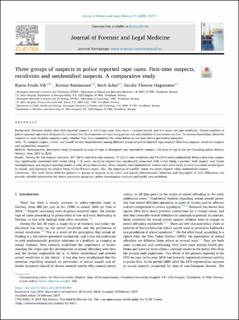| dc.contributor.author | Vik, Bjarte Frode | |
| dc.contributor.author | Rasmussen, Kirsten | |
| dc.contributor.author | Schei, Berit | |
| dc.contributor.author | Hagemann, Cecilie Therese | |
| dc.date.accessioned | 2021-04-27T08:52:06Z | |
| dc.date.available | 2021-04-27T08:52:06Z | |
| dc.date.created | 2019-02-28T13:12:02Z | |
| dc.date.issued | 2019 | |
| dc.identifier.citation | Journal of Forensic and Legal Medicine. 2019, 1-8. | en_US |
| dc.identifier.issn | 1752-928X | |
| dc.identifier.uri | https://hdl.handle.net/11250/2739828 | |
| dc.description.abstract | Background
Previous studies show that reported suspects in adult rape cases often have a criminal record, and that many are rape recidivists. Annual numbers of police reported rapes have dramatically increased but the proportion of rapes being prosecuted and numbers of convictions are low. To increase knowledge about the suspects in cases of police reported rapes; whether they have committed the crime before or not may inform preventive measures.
Aims
To compare suspect, victim, and assault related characteristics among different groups of police-reported rape suspects (first-time suspects, recidivist suspects and unidentified suspects).
Methods
Retrospective, descriptive study of suspects in cases of rape or attempted rape reported by women ≥16 years of age in the Sør-Trøndelag police district, Norway, from 2003 to 2010.
Results
Among the 356 suspects included, 207 (58%) were first-time suspects, 75 (21%) were recidivists and 74 (21%) were unidentified. Being a first-time suspect was significantly associated with victim being <18 years, recidivist suspect was significantly associated with victim being a partner, both suspect- and victim unemployment, and suspect reporting intake of other drugs than alcohol. When suspects were unidentified, victims were more likely to have consumed alcohol prior to assault, and reporting the suspect being of non-Western origin. Also, the reporting of a public venue was more frequent when unidentified suspect.
Conclusions
The study shows different patterns in groups of suspects as to victim and assault characteristics. Detection and description of such differences can provide valuable information for future prevention programs, police investigation methods and health care guidelines. | en_US |
| dc.language.iso | eng | en_US |
| dc.publisher | Elsevier | en_US |
| dc.rights | Navngivelse 4.0 Internasjonal | * |
| dc.rights.uri | http://creativecommons.org/licenses/by/4.0/deed.no | * |
| dc.title | Three groups of suspects in police-reported rape cases: First-time suspects, recidivists and unidentified suspects. A comparative study | en_US |
| dc.type | Peer reviewed | en_US |
| dc.type | Journal article | en_US |
| dc.description.version | publishedVersion | en_US |
| dc.source.pagenumber | 1-8 | en_US |
| dc.source.journal | Journal of Forensic and Legal Medicine | en_US |
| dc.identifier.doi | 10.1016/j.jflm.2019.02.004 | |
| dc.identifier.cristin | 1681360 | |
| cristin.ispublished | true | |
| cristin.fulltext | original | |
| cristin.qualitycode | 1 | |

